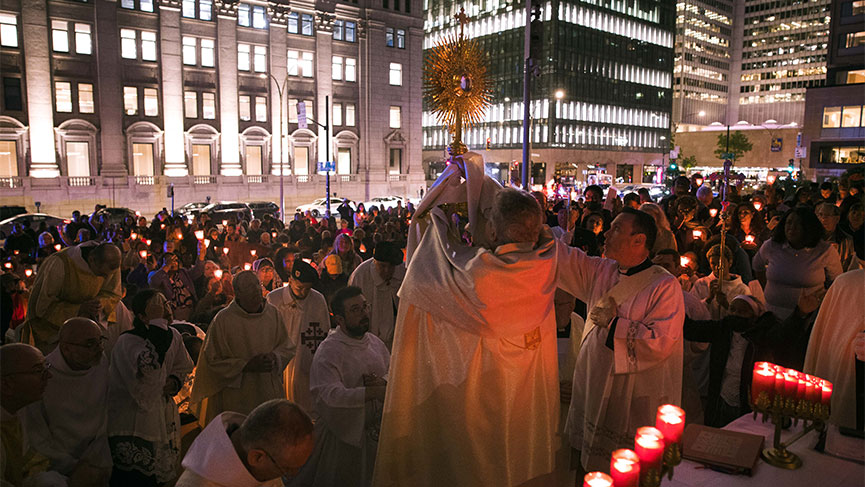Corpus Christi 2023: An experience of collective love

Montreal
Testimonial by Louise Royer (Translated by the Archdiocese of Montreal)
The cathedral was full. A guard of honour formed by the Knights of Columbus and the Equestrian Order of the Holy Sepulchre of Jerusalem embodied the solemnity of the occasion, accompanied by the powerful voice of the cantor and the choir’s pleasing harmonies.
During my meditation in preparation for the Mass, my heart was filled with thanksgiving for the local artisans of social action whom I had met in the afternoon and who, reaching out through the body of Christ, which is the Church, tend to his wounds in the lives of the poor all year round. Joyfully, I recalled that it will soon be the 15th anniversary of that great event, Quebec’s International Eucharistic Congress of 2008, and I heard again the stirring cry of Marguerite Barankitse, "We are the Eucharist!” I asked forgiveness for the sins of my people, in particular for the sin of normalizing and legalizing euthanasia, reproductive surrogacy and the food shortages and scarcity of available housing for the poor. And I remembered in gratitude the peace and unity of the Church that I was able to feel palpably at another Corpus Christi procession one time that I attended with a friend since deceased and her guide dog.
I remembered the devotion of the people of Bolivia, a country where this feast is a national holiday. In fact, the Solemnity of the Most Holy Body and Blood of Christ is celebrated on a Sunday in Canada and certain other countries in accordance with a decision made by the bishops’ conference. The celebration is normally held on the Thursday following the Feast of the Trinity: hence the idea of holding the diocesan Feast of Corpus Christi on this day of the week.
In his homily, Archbishop Lépine explained that this Solemnity signifies the central position of the Eucharist in Christian life - a centrality that makes Jesus Christ in real terms the keystone of our lives. Jesus - his presence in the Eucharist - is not there for his own sake, but rather to bring about a transformation within us, inciting us to love better, to love more, both individually and collectively.
The procession is the physical and symbolic illustration of this love that goes out to encounter the other. The Archbishop exits the Cathedral carrying the monstrance, and he is accompanied by the crowd, holding burning candles. There are no noisy loudspeakers, there is no podium, no canopy, only the evening twilight making way for the procession of the faithful as they move along, serenely and almost in a hush reciting their prayers. Passers-by are astonished, curious, impressed. A statue of the Sacred Heart is displayed in one window, and some of the faithful notice it and take a picture. Friends recognize each other or introduce themselves, exchange a few words and walk together. It is a beautiful moment! On the square in front of the Cathedral, the celebration is concluded with the singing of the hymn Tantum ergo.
But the experience was not over yet! In the metro on the way home, the meetings went on in continuation of this evening of collective love. The work of the Holy Spirit has been well done!

Comment
Comment
Add new comment